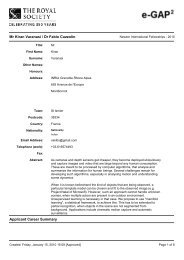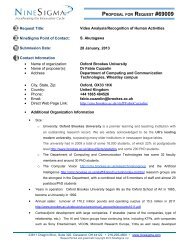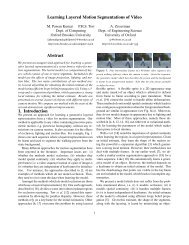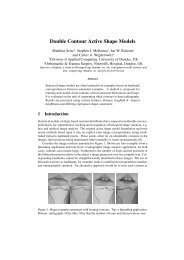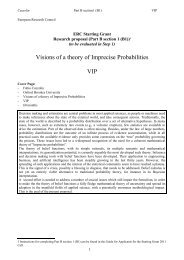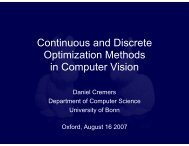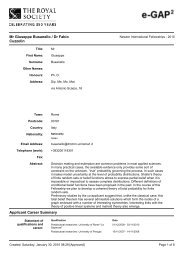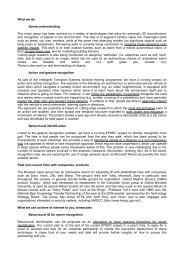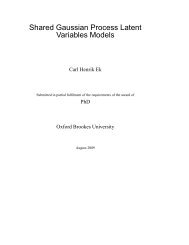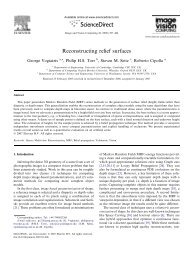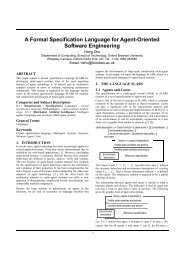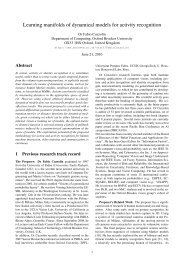Project Proposal (PDF) - Oxford Brookes University
Project Proposal (PDF) - Oxford Brookes University
Project Proposal (PDF) - Oxford Brookes University
You also want an ePaper? Increase the reach of your titles
YUMPU automatically turns print PDFs into web optimized ePapers that Google loves.
FP7-ICT-2011-9 STREP proposal<br />
18/01/12 v1 [Dynact]<br />
Section 3. Impact<br />
3.1 Expected impacts listed in the work programme<br />
3.1.1 Connection with expected impacts in the work programme.<br />
The expected impacts listed in the work programme in relation to Objective 2.1: Cognitive Systems and<br />
Robotics are the following:<br />
“Integrated and consolidated scientific foundations for engineering cognitive systems under a variety<br />
of physical instantiations.”<br />
Giving its breakthrough nature, and the position of its partners at the top of the respective scientific<br />
disciplines, the proposed project is clearly designed to consolidate the scientific foundations within<br />
Europe and at worldwide level in a number of key topics of cognitive systems: generative and<br />
discriminative learning from labelled training sets, the formulation of novel frameworks for robust<br />
action recognition; their testing and application to the variety of physical, societal and industrial<br />
scenarios depicted in Section 1.1.<br />
Actions to undertake: this outcome will be a natural consequence of the successful conclusion of the<br />
project. An appropriate publication strategy will be crucial in this respect. We will also explore, in<br />
the likely case of success, the opportunity of engaging other academic partners in follow-up research<br />
projects addressing the further extension and consolidation of the results obtained: for instance, we<br />
see scope for more focussed, dedicated projects on manifold learning and discriminative modelling,<br />
and wider (possibly IP) projects on the integration between vision and robotics (in terms of both<br />
terrestrial and aerial vehicles), building on our existing record in autonomous navigation.<br />
“Significant increase in the quality of service of such systems and of their sustainability in terms of,<br />
for instance, energy consumption, usability and serviceability, through the integration of cognitive<br />
capabilities.”<br />
An intelligent use of the proposed techniques has the potential to contribute to energy saving and<br />
environmental protection. In surveillance, for instance, automatic event recognition could lead to<br />
more efficient security approaches in which humans do have to waste their time for long hours in<br />
front of static scenes, but are only alerted when some unusual activity is actually taking place.<br />
Efficient tools for gesture recognition can help much in supporting disabled or elderly people, much<br />
improving their quality of life. In video data retrieval, manual search could be significantly sped up<br />
using automatic retrieval techniques, resulting in both energy saving and increased productivity in<br />
the high-tech commercial sectors involved. As a general remark, efficient automatic or semiautomatic<br />
(with human assistance) action recognition has enormous potential for improving the<br />
competitiveness of European players in all involved scenarios, via significant gains in productivity.<br />
“Innovation capacity in a wide range of application domains through the integration of cognitive<br />
capabilities.”<br />
The huge number of scenarios in which the need for robust action and activity recognition arise have<br />
been widely discussed when introducing and motivating the problem: they are reflected in the tasks<br />
the central work package 5 is articulated into: gait identification, entertainment and interactive video<br />
games, video retrieval over the internet, autonomous navigation, animation and facial expression<br />
analysis.<br />
In all these scenarios (and in many others which we mentioned but could not include here for sheer<br />
lack of time and resources, think for instance of human computer interaction, smart homes, and<br />
semi-automatic care for the elderly) a successful outcome of this project will contribute enormously<br />
in terms of both cutting-edge innovation and economic boost for the economic and societal sectors<br />
involved, all the more crucial in times of economic uncertainty and recession.<br />
Companies like Google are heavily investing on video data mining; Street View is just an example<br />
<strong>Proposal</strong> Part B: page [51] of [67]



